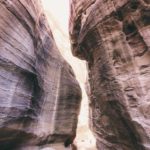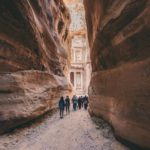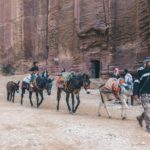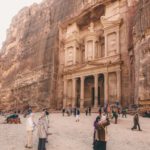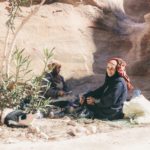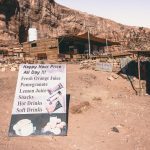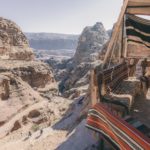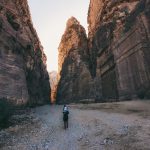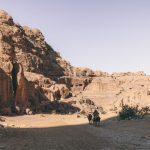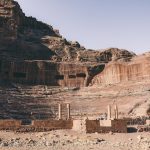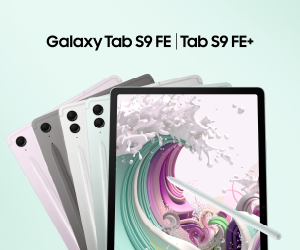![]()
Go on a desert safari in Wadi Rum
A wadi is a desert area that lies dry at all other times of the year than in the rainy season, and if you visit Jordan, you should treat yourself to seeing Wadi Rum, which is the country’s largest wadi.
In Wadi Rum, there is sand as far as the eye can see, and it is a completely unforgettable experience to stand with the afternoon sun in the back and look at the beautiful desert.
The desert has especially become known after being used in Lawrence of Arabia by Steven Spielberg, and one can still see some of the scenery from the film.
We rode with Audh, a Bedouin living in the desert who loved to sit in the sand to listen to the silence and feel the grains of sand between his fingers. However, he was not afraid to drive a little desert race up and down the sand dunes while we sat with great pleasure on the car bed.
In the evening we arrived at a small camp with a campfire site and tents to sleep in. Audh made Jordanian tea and we looked for a long time at the many stars that lit up the sky.
Because we came outside the tourist season, we spent the night there all alone, and the next day we could enjoy breakfast specially made for us while the sun rose over the desert.

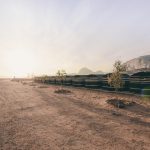
Although the desert is warm during the day, the temperature at night in January can sneak all the way down to 5 degrees. Several layers of rugs, however, make it easy to keep warm.
Float weightless in the Dead Sea
The Dead Sea is 430 meters below sea level, making it the lowest point on Earth’s surface.
The lake is almost 10 times as salty as seawater, and due to its high salinity, no fish can survive – hence the dramatic name.
On the other hand, you see many tourists in the surface of the water, as it is almost impossible not to float. The salt content makes the lake difficult to swim in, so you can just lie back (or on your stomach!) And enjoy the natural skin care.
Even the smallest wounds on the body are noticed, and it is a good idea not to shave just before the visit.
The best way to visit the Dead Sea is by buying access to one of the many resorts located down by the lake. There are typically pools, changing rooms and showers – then you can certainly get the salt rinsed off again.


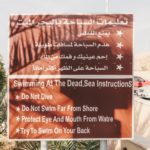
Explore the ancient city of Petra
The archaeological site of Petra is one of the seven new wonders of the world – and rightly so!
The city was possibly established as early as 312 BC, and it served as the capital of the Nabataeans.
In the ancient city there are tombs, temples and impressive buildings carved into beautiful reddish rocks.
It pays to get up early and move out on the long walk towards Petra before the sun gets too bright and the other tourists are awake. Then you have the magical place pretty much to yourself.
After declining a few offers of camel riding, we headed into the siqen; the 1.2-kilometer-long, narrow passage leading to The Treasury (Al-Khazneh).
The sounds of the outside world are shut out, and you can get the feeling of being transported a few thousand years back in time, to the time caravans squeezed through the passage, which in several places is only three meters wide.
All in all, it feels like a perfect entrance to the majestic sights that one encounters during the day.
After the long walk through the siq, you arrive at The Treasury ; Petra’s best known edifice, carved out of sandstone and originally built as a mausoleum by the Nabataeans.
